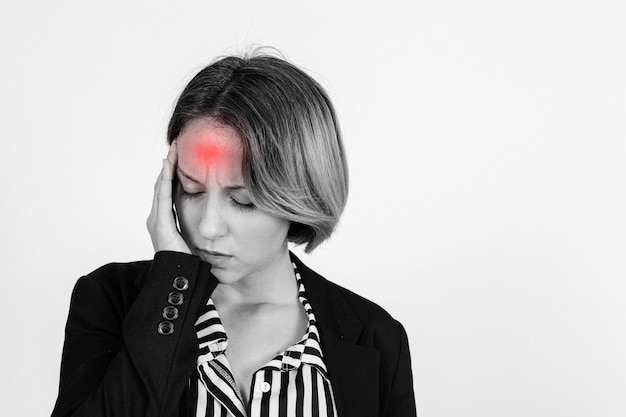
Migraine headaches are the most common type seen in adults, ranging from mild to severe. Migraines often include symptoms like nausea, vomiting, and sensitivity to smells, light, and sound. Studies show this chronic condition is often genetic, affecting one side of the head. Migraine pain can last for 2 to 3 days and worsens with physical activity.
Around 15% of people worldwide suffer from migraines. Although these headaches recur, they can become chronic. Each year, about 2.5% of people with recurring migraines develop chronic migraines, which can cause severe headaches and nausea for up to 15 days each month.
Before a migraine headache, nearly 20% of sufferers experience dizziness, nausea, vomiting, and visual symptoms known as “Aura.” Studies indicate migraines are associated with aura about 1% of the total time, lasting up to one hour with mild or no headache.
**Causes of Migraine Headaches:**
The exact causes of migraine headaches are unknown, but theories suggest several factors. Some studies point to the neurotransmitter serotonin, which affects blood vessels in the brain when its levels fluctuate. Another theory attributes migraines to genetic and environmental factors, including psychological disorders like depression, bipolar disorder, and anxiety.
**Migraine Triggers:**
– Anxiety
– Stress
– Strong smells
– Bright lights
– Loud noises
– Eating and sleeping disorders
– Tension in the neck and shoulder
– Dehydration
Less common triggers include high blood pressure, sleep medications, eye strain, toothaches, smoking, and alcohol. Hormonal changes during periods, pregnancy, and menopause can also affect migraine frequency in women.
**Symptoms of Migraine Headaches:**
Migraines can start with symptoms like difficulty concentrating, fatigue, irritability, and food cravings. Typical migraine symptoms include:
– Severe headache for 2 to 3 days
– Throbbing pain on one side of the head
– Increased pain with physical activity
– Vomiting tendencies
– Sensitivity to smells, light, and noise
About 15 to 30% of migraine sufferers experience migraines with aura. Migraines generally have four phases:
1. Prodrome: Occurs days or hours before the headache
2. Aura: Precedes the headache
3. Pain: The headache phase itself
4. Postdrome: Aftereffects of the migraine
**Relief Methods:**
Home remedies can be effective at the onset of a migraine:
– **Apple Cider Vinegar:** Mix a tablespoon with honey in water to alleviate symptoms.
– **Peppermint Oil:** Massage a few drops on the temples for quick relief.
– **Cayenne Pepper:** It improves blood flow and can ease migraine pain.
– **Ginger:** Blocks inflammation triggers, reducing migraine severity.
– **Feverfew:** An herb that reduces inflammation and spasms.
**Types of Migraines:**
– **Without Aura:** The most common type, characterized by nausea, blurred vision, and sensitivity to light and noise, lasting 2 to 3 days.
– **With Aura:** Includes visual disturbances and neurological symptoms, usually lasting less than an hour.
Other types include:
– **Migraine Without Headache:** Involves visual or other aura symptoms without a headache.
– **Migraine with Brainstem Aura:** Affects mainly children and teens, often linked to the menstrual cycle.
– **Hemiplegic Migraine:** Rare but severe, causing temporary paralysis and other serious symptoms.
– **Retinal Migraine:** Features vision problems and visual auras.
– **Chronic Migraine:** Occurs episodically with headaches on more than 15 days a month.
**Diagnosis:**
Diagnosing migraines relies on reported symptoms, as no specific tests are available. A doctor may request medical history and perform a physical and neurological exam. CT scans or MRIs may be used to rule out other conditions but do not diagnose migraines.
**Medications:**
Various treatments include:
– **OTC Painkillers:** Aspirin, ibuprofen, and paracetamol can provide relief.
– **Triptans:** If OTCs aren’t effective, triptans may help by controlling serotonin.
**Prevention:**
Prevent migraines by taking medications, supplements, altering your lifestyle, and avoiding triggers. Overusing painkillers can lead to additional headaches, so preventive measures are crucial:
– **Injections:** BOTOX is effective for chronic migraines.
– **Weight Loss:** Reducing weight can decrease migraine frequency.
– **Avoid Sun Exposure:** Heat can trigger migraines, so staying cool helps.
**Conclusion:**
Migraine headaches include symptoms like nausea and sensitivity to smells, light, and noise, typically lasting 2 to 3 days. Migraine triggers include stress, sleep issues, anxiety, hormonal changes, and certain foods. Relief can come from medications or home remedies like apple cider vinegar, ginger, and peppermint oil. Prevent chronic migraines by adjusting lifestyle habits, like avoiding sun exposure and staying hydrated.